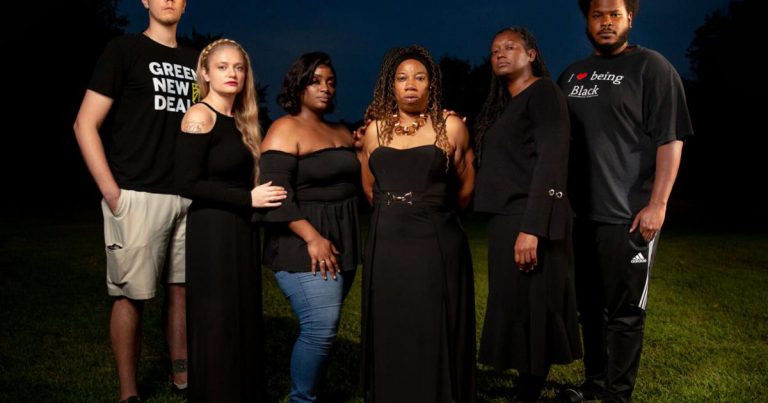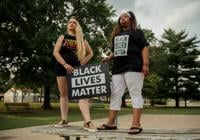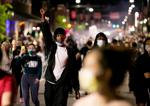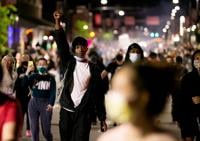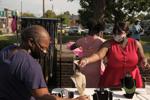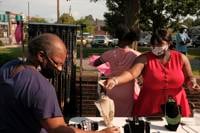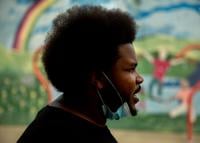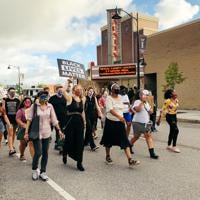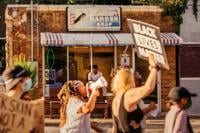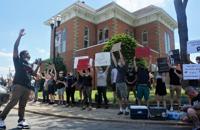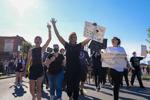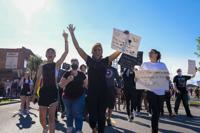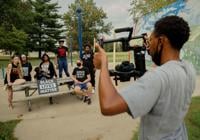CARBONDALE — In the weeks and months after George Floyd’s death while pinned under the knee of a Minneapolis police officer, demonstrations spread throughout the country and world — and throughout Southern Illinois.
The social justice movement spurred by Floyd’s death, which seeks racial equality and has primarily focused on reform in the criminal justice system, isn’t a new one. Nancy Maxwell, a community organizer from Marion, notes the public may see activism in waves over time, but it’s a fight for the same cause. “We’ve been marching for 50 years now and we shouldn’t have to be in this position to keep marching about the same thing — being mistreated for the color of your skin,” she said.
Community organizers Elise Grabowska, of Carbondale, and Nancy Maxwell, of Marion, pose while recording a video on Sunday in Attucks Park in Carbondale. The group shot the video to promote an upcoming demonstration in Vienna.
Matt Wilson, a community organizer from Carbondale, shared similar sentiments. “The fight has never ended,” he said. “We studied civil rights in history classes, but the same goals and outcomes they were trying to achieve back then are the same ones we’re still trying to achieve. You can’t let the flame die — the torch must always be lit.”
A candlelight vigil held days after Floyd died brought hundreds from the region to Lenus Turley Park in Carbondale. Chastity Mays, a Carbondale mother who planned the event alongside her family, said it was “impactful (to) look out and see such a diverse crowd” and even recalls seeing some people become emotional during the event. “I saw people cry in the audience,” she said. “Tears of a community coming together and acknowledging there’s a big problem we have to solve.”
Subsequent demonstrations have varied in size — from only a few people to a June demonstration that brought roughly 800 people to the streets of Carbondale. In the last couple of months, marches have been on the smaller side in Southern Illinois. Some organizers across the country have noted the realities of activism fatigue. “At the end of the day, every day, I feel burned out,” Chanelle Helm, the co-founder of Black Lives Matter Louisville said in a 2018 interview with Vice. “The fact is, you’re putting in so much work and don’t always see the results.”
Maxwell has seen a similar fatigue, she said, recalling the 2012 death of Travon Martin, an unarmed Black 17-year-old boy who was shot and killed by a white man. “People were marching everywhere. I even marched here with a group and it was all over the world,” she said. “But then … it just stopped.”
While Maxwell saw a similar trajectory after the first few marches this summer, she said this time it had to be different. “I don’t feel like you can quit, you just have to keep going,” she said.
Shortly after Floyd’s death, the So. Ill. Unity Coalition was formed. The group is a self-described “collective of community activists and allies working together to unify the Southern Illinois community through a combination of grassroots efforts and innovative approaches.” The group is made up of various community members across ages and walks of life, including students, business professionals, mothers and community advocates. All have the same goal: keep the movement for change treading forward.
The So. Ill. Unity Coalition released this video on Friday to promote an upcoming event in Vienna.
The So. Ill Unity Coalition has organized marches, and they have continued their activism through events designed to bring the community together, including variety shows and shopping events highlighting local Black businesses. Members of the group said their mission goes beyond the protest and relies on being in touch with the community and their needs while celebrating those who are a part of it.
“A way to unite people is to have them in good spirits,” Wilson said. “With the multitude of negative things we see in the media — from the killings and everything else, we need some kind of positivity. If we can come together through music, through dance or through something else to unify us, that’s what we need to do.”

Matt Wilson, of Carbondale, gives directions to other community organizers while recording a promotional video on Sunday in Attucks Park in Carbondale.
Maxwell said it can be difficult to surround themselves with such heavy topics all the time without having an outlet. She noted the group had a mental health professional speak at a recent variety show. Later in the event, music was played over speakers and attendees danced. The balance between more celebratory events and demonstrations, she said, is important.
“You need something that is not always straight focused on the problem. We’re going to have days when it’ll be more peaceful and we’re going to have times when we march,” she said. “But, at the end of the day, we’re not going to stop and we’re trying to keep the focus on this (movement) like they are in big cities — there is hope.”
Elise Grabowska recently moved to Carbondale from Minnesota with her husband, Alex, and now works with the physician assistant program with the Southern Illinois University School of Medicine. Grabowska, who is white, said being an ally to those who are calling for change is critical in amplifying marginalized communities, especially in Southern Illinois.
“It’s important being a white ally to listen, because it is impossible to understand the world that BIPOC (black, indigenous, people of color) people live in when the world that white people live in is completely different,” she said. “It’s different dangers, different comforts, different privileges, different oppressions, and to think that we, as white people, can completely understand the circumstances people of color … face everyday is kind of absurd.”

Demonstrators march past The Varsity Center on Friday, Aug. 28 during a demonstration in Carbondale commemorating the anniversary of the 1963 March on Washington.
There are multiple steps in being a good ally, Grabowska said, and she notes one of the most important steps is “making sure your view is intersectional and you’re not putting people into boxes that align with different stereotypes,” realizing each person has their own unique experiences that have led them to the lives they live and circumstances they face today.
Emerald Avril, a community activist from Carbondale, said seeing the amount of support for their causes from people of different backgrounds has been one of the things that has stood out to her the most. “I grew up here, so seeing so many allies really makes me really want to keep going because a lot of times when people are lost, they will follow after they see consistency,” she said. “It’s encouraging to see people that don’t look like you that want to fight for your right to be a human being.”

Demonstrators march past Arnette’s Barber Shop on Friday, Aug. 28 during a march in Carbondale commemorating the anniversary of the 1963 March on Washington.
Grabowska said it can, at times, be a challenge drumming up support for the social justice movement in rural communities due to smaller populations as well as geopolitical hurdles — Southern Illinois spans over 7,000 square miles. She said, generally, more rural communities may lean on the conservative side, and some may not see the full picture of the social justice movement as compared to their counterparts in more highly populated cities.
“I think in Southern Illinois, there are areas where you can go to engage with different communities and there are other areas that you can go to if you want to completely isolate yourselves from marginalized communities,” Grabowska said. Many Southern Illinois communities’ populations where demonstrations have taken place are predominately white — Carbondale’s population is over 60% white, Benton’s population is about 92% white, Anna’s population is about 90% white and Carterville’s population is almost 90% white.
Mays said it is important to continue fighting for social justice and racial equality in small-town America because of racist ideologies that still may be embedded in some communities. “The majority of America is (made up of) small towns, and I think cities are more progressive in the way they think and have a more diverse population, so they may not have as much racial discrimination as small towns,” she said. “Honestly, the small towns are where the work has to be put in.”
This tenacious group of local activists has been doing just that — putting in the work for their cause. As social media has given traction to various activist events, in large cities and small towns, organizers say they have “the ear of America this time,” while adding the work they are putting in will help form a better future for younger generations.
“If we want to see something better for them, we have to teach them and train them and educate them so they will continue to fight for the dream that we had,” Wilson said. “It’s important to keep this going so that the youth can see and be inspired and one day grow up and continue on just like we did.”
Maxwell agreed and said it was important to acknowledge those who have led the path in years past while continuing to fight for equality and justice and laying the groundwork for those to come. “We must never underestimate the power of planting a seed, she said. “When we’re out there marching — we’re planting the seeds.”

Eyaan Mahone, a Carbondale-based cinematographer, films members of the So. Ill Unity Coalition for a promotional video on Sunday in Attucks Park in Carbondale. The group made the video to promote an upcoming demonstration in Vienna.
Organizers said they are continuing to show Southern Illinois they support marginalized communities and won’t stand for racism. The group announced Friday they will be holding a peaceful demonstration and rally in Vienna at 2 p.m. Sept. 27.
The action comes after a Black student experienced “acts of racism” with “a lack of support from the high school,” organizers said. The goal of the event, they said, is to “raise awareness and show the Black community of Southern Illinois that we will continue to demand justice.”


